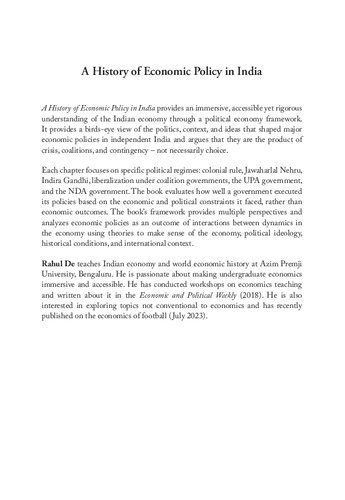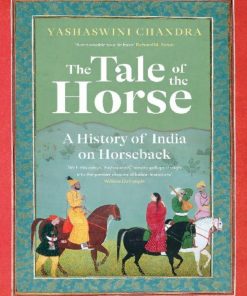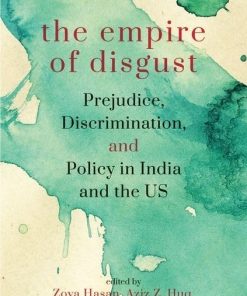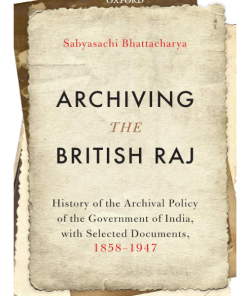(Ebook PDF) A History of Economic Policy in India Crisis Coalitions and Contingency 1st edition by Rahul De ISBN 9781009383950 1009383957 full chapters
$50.00 Original price was: $50.00.$25.00Current price is: $25.00.
(Ebook PDF) A History of Economic Policy in India Crisis Coalitions and Contingency 1st edition by Rahul De-Ebook PDF Instant Download/Delivery:9781009383950, 1009383957
Instant download Full Chapter of A History of Economic Policy in India Crisis Coalitions and Contingency 1st edition after payment

Product details:
ISBN 10: 1009383957
ISBN 13: 9781009383950
Author: Rahul De
Table of contents:
- Introduction
- The Colonial Economy – 1776–1947
- The Drive to Industrialize under Nehru’s Leadership – 1950–66
- The Turn to Populism under Indira Gandhi – 1967–79
- The Early Liberalization Years – 1980–2003
- Maturity of Reforms in the UPA Years – 2004–13
- Reforms under NDA – 2014–19
- 1 Colonialism and the Indian Economy
- The Great Divergence
- Why India Was Important to Britain
- How Did the EIC Create the Indian Economy?
- How Colonial Policies Shaped Indian Industries
- The Roots of Colonial Resistance
- The Critique of Home Charges
- World War 1
- World War 1 and Its Impact on Indian Industries
- Colonial Policies Encouraging Domestic Industries
- The Great Depression of 1929
- The Great Depression of 1929 and How It Impacted the Satyagraha Movement
- The Impact of the Great Depression on the Indian Economy
- The Changing Structure of the Indian Economy in the Early Twentieth Century
- The Rise of the INC as the Face of the Independence Movement
- India’s Role in World War 2 and How It Contributed to Independence
- State of the Indian Economy on the Eve of Independence
- References
- 2 The Drive to Industrialize under Nehru’s Leadership1950–66
- Inheriting the Colonial Economy
- Models of Economic Development
- India’s Unique Development Path under Nehru’s Direction
- Mixed Economy: The Middle Path
- Planning
- Political Responses to Nehruvian Mixed Economy Industrialization Development Model
- Industrial Policy
- Agricultural Sector
- Agricultural Policy
- External Policy
- How Did Nehruvian Policies Affect the Indian Economy?
- The Political Economy of Nehruvian Policy: Who Benefits?
- Shortcomings of Nehruvian Policy
- The Failure of Land Redistribution
- The Problem with the Planning Mechanism
- The 1965 Food Crisis and the End of the Nehruvian Policy Regime
- References
- 3 The Turn to Populism under Indira Gandhi 1967–79
- The Nehruvian Regime and the Crisis of 1965–66
- Dilution of Nehruvian Policy and the Turn to Liberal Reforms
- Internal Struggles in the INC and the Weakening of the PC
- Devaluation and the Dilution of Import Substitution Policies
- Green Revolution: Liberalization in the Agricultural Sector
- New Agricultural Strategy
- The Formation of the Food Commission of India
- Why Was It Referred to as the Green Revolution?
- The Impact of the NAS on the Indian Economy
- Criticism of the NAS
- The First Moment of Liberalization
- Destabilization of Government and the INC Split
- Infighting within the INC
- INC Split in 1969
- The Populist Turn under Indira Gandhi
- The Attack on Heavy Industry
- Curb on the Bargaining Powers of Organized Labor
- State of Emergency: 1975
- Making Sense of the Indira’s Political Regime: The Class Basis of Indira’s Policies
- Crisis of 1979
- References
- 4 The Early Liberalization Years 1980–2003
- What Are Liberal Reforms?
- Liberalization in 1980
- Impact of Partial Reforms in the 1980s on the Economy
- Liberalization in 1991
- Why 1991 Is Associated with Liberal Reforms
- The Foreign Exchange Crisis of 1991
- The Introduction of Reforms in 1991
- The Role of Private English Media
- Manmohan Singh’s Budget Speech
- The Impact of Reforms on the Economy
- Why Reforms in 1991 Did Not Have the Desired Effect on Industry and Exports
- How Reforms Reshaped Federal Politics in India
- The Impact of Reforms on the Agricultural Sector
- Who Benefited from Reforms?
- Reforms under the NDA Government
- Conclusion
- References
- 5 Maturity of Reforms in the UPA Years 2004–13
- How Was the UPA Different from Other Coalition Governments?
- Common Minimum Program
- National Advisory Council
- The Economy under the UPA
- Why Manufacturing Sector Growth Was Not Sustainable in This Period
- Government Spending Troubles and Fiscal Responsibility and Budget Management Act of 2003
- Informal Labor
- SEZA: Decentralizing the Process of Reforms
- The Process and Politics that Shaped the SEZA
- Reforms with a Human Face: Rights-Based Social Policy Introduced by the UPA
- The Infrastructure for Rights-Based Social Policy
- Unique Identification Authority of India (UIDAI) and Identification
- The Role of Civil Society and Non-Governmental Organizations (NGOs)
- Right to Information Act, 2005
- The National Rural Employment Guarantee Act, 2005
- Social Rights Policies Introduced by the UPA
- Conclusion
- References
- 6 Reforms under the NDA Government 2014–19
- Electoral Strategy
- The NDA’s Economic Philosophy
- The BJP’s Election Manifesto, 2014
- Economic Survey, 2013–14
- NITI Aayog
- The Indian Economy under the NDA
- NDA I’s Economic Policies
- Welfare Policy under the NDA
- Digital Delivery Mechanism
- Demonetization
- Goods and Services Tax
- Pradhan Mantri Jan Arogya Yojana
- Agrarian Distress and Farm Bill
- Conclusion
People also search:
what is indian economic policy
economic policies in india
history of india’s economic development
history of india’s economy
india’s economic history
Tags:
Rahul De,History,Economic Policy,India,Crisis,Coalitions,Contingency
You may also like…
Politics & Philosophy - Government & Politics Society
Social Policy in a Cold Climate: Policies and their Consequences since the Crisis 1st edition
Science (General) - Research & Development
Science, Technology and Innovation in the History of Economic Thought 1st Edition
Uncategorized
Politics & Philosophy
Social Norms, Gender and Collective Behaviour: Development Paradigms in India Indranil De
Politics & Philosophy - Social Sciences
Politics & Philosophy - Government & Politics
Crisis Rhetoric and Policy Change in China 1st Edition Yihong Liu
Politics & Philosophy
History - Indian History
Politics & Philosophy - Social Sciences











